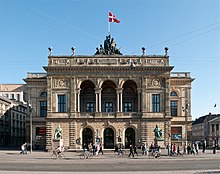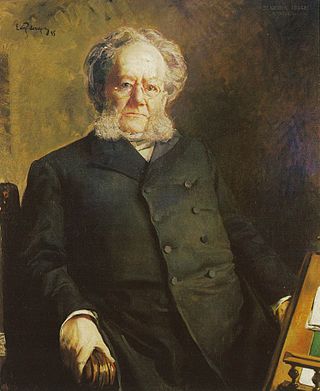
Henrik Johan Ibsen was a Norwegian playwright and theatre director. As one of the founders of modernism in theatre, Ibsen is often referred to as "the father of realism" and one of the most influential playwrights of his time, as well of one of the most influential playwrights in Western literature more generally. His major works include Brand, Peer Gynt, Emperor and Galilean, A Doll's House, Ghosts, An Enemy of the People, The Wild Duck, Rosmersholm, Hedda Gabler, The Master Builder, and When We Dead Awaken. Ibsen is the most frequently performed dramatist in the world after Shakespeare, and A Doll's House was the world's most performed play in 2006.
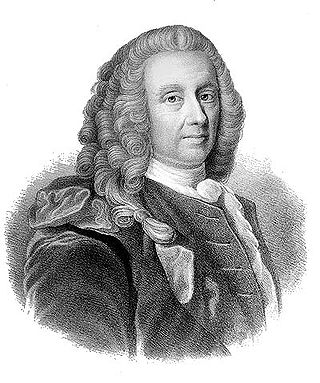
Ludvig Holberg, Baron of Holberg was a writer, essayist, philosopher, historian and playwright born in Bergen, Norway, during the time of the Dano–Norwegian dual monarchy. He was influenced by Humanism, the Enlightenment and the Baroque. Holberg is considered the founder of modern Danish and Norwegian literature. He was also a prominent Neo-Latin author, known across Europe for his writing. He is best known for the comedies he wrote in 1722–1723 for the Lille Grønnegade Theatre in Copenhagen. Holberg's works about natural and common law were widely read by many Danish law students over two hundred years, from 1736 to 1936.

The culture of Denmark has a rich artistic and scientific heritage. The fairy tales of Hans Christian Andersen (1805–1875), the philosophical essays of Søren Kierkegaard (1813–1855), the short stories of Karen Blixen, penname Isak Dinesen, (1885–1962), the plays of Ludvig Holberg (1684–1754), modern authors such as Herman Bang and Nobel laureate Henrik Pontoppidan and the dense, aphoristic poetry of Piet Hein (1905–1996), have earned international recognition, as have the symphonies of Carl Nielsen (1865–1931). From the mid-1990s, Danish films have attracted international attention, especially those associated with Dogme 95 like those of Lars Von Trier. Denmark has had a strong tradition of movie making and Carl Theodor Dreyer has been recognised as one of the world's greatest film directors. The astronomical discoveries of Tycho Brahe (1546–1601), Ludwig A. Colding's (1815–1888) neglected articulation of the principle of conservation of energy, and the foundational contributions to atomic physics of Niels Bohr (1885–1962); in this century Lene Vestergaard Hau in quantum physics involving the stopping of light, advances in nano-technology, and contributions to the understanding of Bose-Einstein Condensates, demonstrate the range and endurance of Danish scientific achievement.

The earliest traces of Danish music go back to the many twisting Bronze-Age horns or lurs which some experts have identified as musical instruments. They have been discovered in various parts of Scandinavia, mostly Denmark, since the end of the 18th century. Denmark's most famous classical composer is Carl Nielsen, especially remembered for his six symphonies, while the Royal Danish Ballet specializes in the work of Danish choreographer August Bournonville. Danes have distinguished themselves as jazz musicians, and the Copenhagen Jazz Festival has acquired an international reputation. The modern pop and rock scene has produced a few names of note, including MØ, Dizzy Mizz Lizzy, Lukas Graham, D-A-D, Tina Dico, Aqua, The Raveonettes, Michael Learns to Rock, Volbeat, Alphabeat, Safri Duo, Medina, Oh Land, Kashmir, King Diamond, Outlandish, and Mew. Lars Ulrich is the first Danish musician to be inducted into the Rock and Roll Hall of Fame.

Johanne Luise Heiberg was a Danish actress of the 19th century. She is most famous for her work at the Royal Theatre in Copenhagen, where she achieved great success. Though she was closely connected to the romantic tradition, Heiberg is still regarded as a key figure of Danish drama. She contributed to the growing public social and moral perception of Danish actors as artists and cultural personalities rather than simply performers.

Danish literature stretches back to the Middle Ages. The earliest preserved texts from Denmark are runic inscriptions on memorial stones and other objects, some of which contain short poems in alliterative verse. In the late 12th century Saxo Grammaticus wrote Gesta Danorum. During the 16th century, the Lutheran Reformation came to Denmark. During this era, Christiern Pedersen translated the New Testament into Danish and Thomas Kingo composed hymns. Fine poetry was created in the early 17th century by Anders Arrebo (1587–1637). The challenges faced during Denmark's absolute monarchy in 1660 are chronicled in Jammersminde by Leonora Christina of the Blue Tower. Ludvig Holberg (1684–1754), influenced by the ideas of the Enlightenment and Humanism, is considered the founder of modern Danish and Norwegian literature. Neoclassical poetry, drama, and the essay flourished during the 18th century influenced by French and English trends. German influence is seen in the verse of the leading poets of the late 18th century such as Johannes Ewald and Jens Baggesen. Other 18th century writers include the hymn writer Hans Adolph Brorson and the satirical poet Johan Herman Wessel.
Leif Thormod Panduro was a Danish writer, novelist, short story writer, and dramatist.
Lisbeth Cathrine Amalie Rose née Böttger was a Danish actress, one of the first professional native actresses in Denmark, and also referred to as the greatest actress in 18th century Denmark. She was also a translator and a playwright.
Carl Erik Soya,, also known by the single appellation Soya, was a Danish author and dramatist. His works were often satirical provocations against double standards and dishonesty. In 1975, Soya received Denmark's foremost literary award, Grand Prize of the Danish Academy.
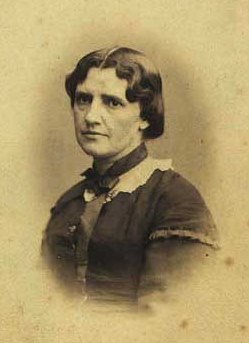
Anna Magdalene Thoresen, née Kragh was a Danish-born Norwegian poet, novelist, short story writer and playwright. She is said to have inspired a number of other writers to model characters after her. Her stepdaughter, Suzannah Ibsen, was married to Henrik Ibsen. A selection of her letters has been published as Breve fra Magdalene Thoresen 1855-1901.
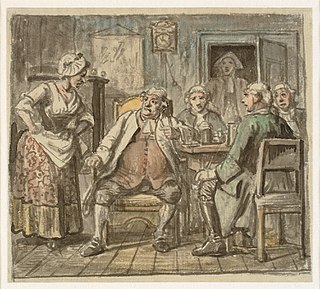
The Political Tinker is a five-set satirical play published by Norwegian-Danish playwright Ludvig Holberg in 1722.

Theobald Stein was a Danish sculptor. He was a professor at the Royal Danish Academy of Fine Arts and served as its director from 1883 to 1886.

Oda Laurenze Helmine Nielsen née Larsen (1851–1936) was a highly acclaimed Danish actress who performed both in private theatres in Copenhagen and at the Royal Danish Theatre. Inspired by French actresses, she played the roles of attractive young women, for example in the title roles of Frøken Nitouche and Victorien Sardou's Dora. She later took on roles where she sang, imitating the French singer Yvette Guilbert. This increased her popularity not only in Scandinavia but also in the United States where she performed for Danish audiences. One of her favourite roles in later life was Grevinde Danner in Sven Leopold's Hos Grevinden.
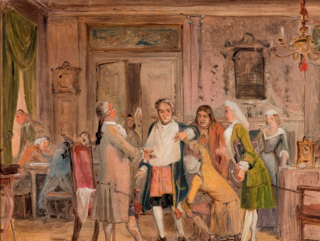
The Fidget is a satirical play published by Ludvig Holberg in 1723. It premiered at Lille Grønnegade Theatre in Copenhagen on 25 November 1726.
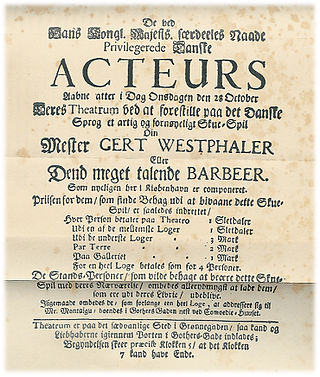
Gert Westphaler or The Loquacious Barber is a satirical play written by the Norwegian-Danish playwright Ludvig Holberg. It premiered in five sets at the Lille Grønnegade Theatre in Copenhagen on 28 October 1722 but Holberg later adapted it into a one- set version.
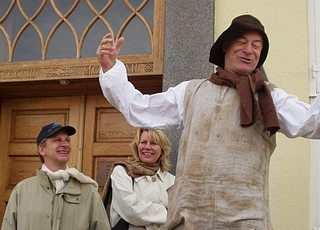
Kirsten Olesen is a Danish actress who since 1979 has been with Copenhagen's Royal Danish Theatre. In Denmark, she is known above all for taking the part of Agnes, a housemaid, in the popular television series Matador (1978–1982). Internationally, she has starred in the title role of Lars von Trier's Medea (1988).
Christian Lollike is a Danish playwright, theater director and artistic director of Sort/Hvid in Copenhagen. Lollike is working with stage and installation art in theaters, public areas and virtual platforms. He has made theater, film, musicvideo, opera, dance and art interventions. He often uses current political events in his work.

The statue of Ludvig Holberg by Theobald Stein, together with Herman Wilhelm Bissen's statue of Adam Oehlenschläger, flanks the main entrance to the Royal Danish Theatre on Kongens Nytorv in Copenhagen, Denmark. It was created by Stein in conjunction with the inauguration of Vilhelm Dahlerup's new theatre building in 1875. Bissen's statue of Oehlenschläger is from 1861 and was originally located on Sankt Annæ Plads.
Brigitte Käthe Kolerus (1941–2001) was an Austrian-born Danish actress who performed in films and on television but mainly on stage. After studying at the Odense Teater drama school, she appeared in the musical Man of La Mancha at Ungdommens Teater in 1967 and went on to play Desdemona in Shakespeare's Othello at Det Danske Teater in 1969. She made a name for herself in films by appearing in erotic scenes in Erik Frohn Nielsen's Ekko af et skud in 1970. Kolerus also served as director of Copenhagen's Teatret ved Sorte Hest from 1978 and staged plays and operas at a number of venues.

Christen Niemann Rosenkilde was a Danish actor and writer.
